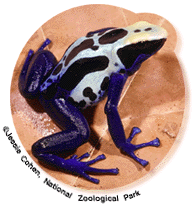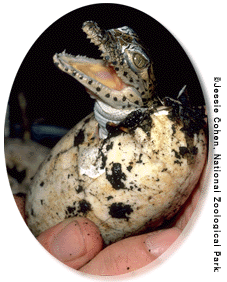| Essay, part 1 Introduction Essay, part 2 Who's a Herp? Essay, part 3 Our Views of Herps Essay, part 4 Herps Need Our Help |
 Who's
a Herp?
Who's
a Herp?
When people talk about herps as a group, they're referring to thousands of species of animals. All of those animals belong to either one of the three major groups of amphibians or one of the four major groups of reptiles. Here's the breakdown:
Amphibians Reptiles |
A Distant Connection 
At one time, naturalists thought reptiles and amphibians were close "cousins," which is one reason the two groups were originally put together under the zoological umbrella of herpetology. Herpetology is derived from the Greek word herpeton, meaning "crawling things." But although there's a definite connection – reptiles and amphibians evolved from a common ancestor millions of years ago – the two groups aren't closely related.
Still, reptiles and amphibians have several things in common. For example, both are ectothermic (externally heated), and both usually shed their skin several times a year. Many herps also have special cells that cause the color of their skin to lighten, darken, or change altogether. And many have an organ in the roof of the mouth, called the Jacobson's organ, that senses odor particles.
Points of Departure
So what's the difference between reptiles and amphibians? Actually, there are quite a few differences. For example, unlike reptiles, amphibians usually lay unshelled eggs in water, while reptiles lay shelled eggs on land. Many young amphibians, equipped with gills, live in water for some time after hatching. Baby reptiles are often miniature versions of the adults while baby amphibians often don't look much like their parents. Young amphibians gradually change into their adult forms through the process of metamorphosis.
Even though some adult amphibians live on land, their skin must remain moist at all times. Their skin produces a coating of mucus and keeps the animals from drying out. Reptiles, in contrast, have scales covering dry skin. So despite what a lot of people grow up believing, snakes, lizards, and other reptiles aren't the least bit slimy. That distinction belongs to frogs, salamanders, and some of the other amphibians.
